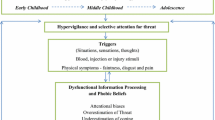Abstract
Blood-Injection-Injury (BII) phobia is associated with distress and avoidance in response to blood, injury, or receiving injections. BII phobia can therefore create problems for those receiving medical procedures such as chemotherapy. The prevalence rate of BII in the general population has been estimated to be less than 5% but as many as 19% of outpatients receiving chemotherapy surveyed by Carey and Harris (Behaviour Change 22:5–90, 2005) reported BII concerns. This study examined the extent and characteristics of BII concerns among outpatients receiving chemotherapy for the first time (n = 124). Almost 17% of the sample had scores on the Mutilation Questionnaire comparable to samples with clinical BII phobia. Those assigned to a high BII concern group based on Mutilation Questionnaire scores reported higher somatic and fainting responses to BII stimuli and elevated disgust sensitivity, compared to groups selected for low BII concerns. Females had significantly higher Mutilation Questionnaire scores than males. Thus, the BII concerns of outpatients receiving chemotherapy appear qualitatively similar to the concerns reported by clinical BII phobia samples and analogue student samples. We suggest that the standard inclusion of a brief, reliable screening measure of BII concerns for outpatients scheduled for chemotherapy, coupled with brief, effective interventions to reduce BII-related distress, may be warranted.
Similar content being viewed by others
References
Agras, S., Sylvester, D., & Oliveau, D. (1969). The epidemiology of common fears and phobia. Comprehensive Psychiatry, 10, 151–156.
American Psychiatric Association (2000). Diagnostic and Statistical Manual of Mental Disorders (4th ed Text Revised.). Washington, DC: American Psychiatric Association.
Bienvenu, O., & Eaton, W. (1998). The epidemiology of blood-injection-injury phobia. Psychological Medicine, 28, 1129–1136.
Carey, C., & Harris, L. M. (2005). The origins of blood-injection fear/phobia in cancer patients undergoing intravenous chemotherapy. Behaviour Change, 22, 85–90.
Davey, G., & Matchett, G. (1994). Unconditioned stimulus rehearsal and the retention and enhancement of differential “fear” conditioning: Effects of trait and state anxiety. Journal of Abnormal Psychology, 103, 708–718.
De Jongh, A., Adair, P., & Meijerink-Anderson, M. (2005). Clinical management of dental anxiety: what works for whom? International Dental Journal, 55, 73–80.
de Jong, P., & Merckelbach, H. (1998). Blood-injection-injury phobia and fear of spiders: Domain specific individual differences in disgust sensitivity. Personality and Individual Differences, 24, 153–158.
Deacon, B., & Abramowitz, J. (2006). Fear of needles and vasovagal reactions among phlebotomy patients. Anxiety Disorders, 20, 946–960.
Haidt, J., McCauley, C., & Rozin, P. (1994). Individual differences in sensitivity to disgust: A scale sampling seven domains of disgust elicitors. Personality & Individual Differences, 16, 701–713.
Kendler, K., Myers, J., Prescott, C., & Neal, M. (2001). The genetic epidemiology of irrational fears and phobias in men. Archives of General Psychiatry, 58, 257–265.
Kettwich, S., Sibbitt, W., Brandt, J., Johnson, C., Wong, C., & Bankhurst, A. (2007). Needle phobia and stress-reducing medical devices in pediatric and adult chemotherapy patients. Journal of Pediatric Oncology Nursing, 24, 20–28.
Kleinknecht, R. A. (1994). Acquisition of blood, injury, and needle fears and phobias. Behaviour Research & Therapy, 32, 817–823.
Kleinknecht, R. A., & Thorndike, R. M. (1990). The Mutilation Questionnaire as a predictor of blood/injury fear and fainting. Behaviour Research and Therapy, 28, 429–437.
Klorman, R., Hastings, J., Weerts, T., Melamed, B., & Lang, P. (1974). Psychometric description of some specific-fear questionnaires. Behavior Therapy, 5, 401–409.
Koch, M., O’Neill, H., Sawchuk, C., & Connolly, K. (2002). Domain-specific and generalized disgust sensitivity in blood-injection-injury phobia: The application of behavioral approach/avoidance tasks. Journal of Anxiety Disorders, 16, 511–527.
Marks, I. (1988). Blood-injury phobia: a review. American Journal of Psychiatry, 145, 1207–1213.
Merckelbach, H., Muris, P., de Jong, P. J., & de Jongh, A. (1999). Disgust sensitivity, blood-injection-injury fear, and dental anxiety. Clinical Psychology and Psychotherapy, 6, 279–285.
Olatunji, B., Arrindell, W., & Lohr, J. (2005). Can the sex differences in disgust sensitivity account for the sex differences in blood-injection-injury fears? Personality and Individual Differences, 39, 61–71.
Olatunji, B., Sawchuk, C., de Jong, P., & Lohr, J. (2006). The structural relation between disgust sensitivity and blood-injection-injury fears: A cross-cultural comparison of US and Dutch data. Journal of Behavior Therapy and Experimental Psychiatry, 37, 16–29.
Oliver, N., & Page, A. (2008). Effects of internal and external distraction and focus during exposure to blood-injury-injection stimuli. Journal of Anxiety Disorders, 22, 283–291.
Öst, L.-G. (1991). Acquisition of blood and injection phobia and anxiety response patterns in clinical patients. Behaviour Research & Therapy, 23, 27–34.
Öst, L.-G. (1992). Blood and injection phobia: Background and cognitive, physiological, and behavioral variables. Journal of Abnormal Psychology, 101, 68–74.
Page, A. C. (1994). Blood-injury phobia. Clinical Psychology Review, 14, 443–461.
Page, A. C., Bennett, K. S., Carter, O., Smith, J., & Woodmore, K. (1997). The Blood-Injection Symptom Scale (BISS): Assessing a structure of phobic symptoms elicited by blood and injections. Behaviour Research & Therapy, 35, 457–464.
Sawchuk, C., Lohr, J., Tolin, D., Lee, T., & Kleinknecht, R. (2000). Disgust sensitivity and contamination fears in spider and blood-injection-injury phobias. Behaviour Research and Therapy, 38, 753–762.
Schienle, A., Stark, R., Walter, B., & Vaitl, D. (2003). The connection between disgust sensitivity and blood-related fears, faintness symptoms, and obsessive-compulsiveness in a non-clinical sample. Anxiety, Stress & Coping: An International Journal, 16, 185–193.
Author information
Authors and Affiliations
Corresponding author
Rights and permissions
About this article
Cite this article
Harris, L.M., Jones, M.K. & Carey, C.L. Characteristics of Blood-Injection-Injury Fears in People Receiving Intravenous Chemotherapy. Curr Psychol 28, 124–132 (2009). https://doi.org/10.1007/s12144-009-9048-z
Published:
Issue Date:
DOI: https://doi.org/10.1007/s12144-009-9048-z




